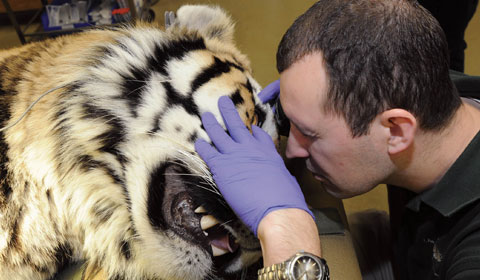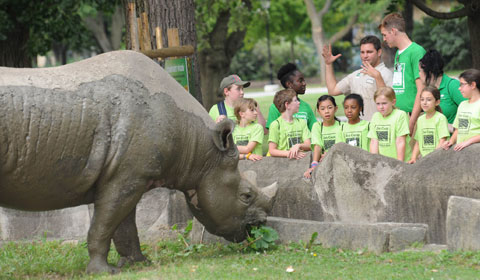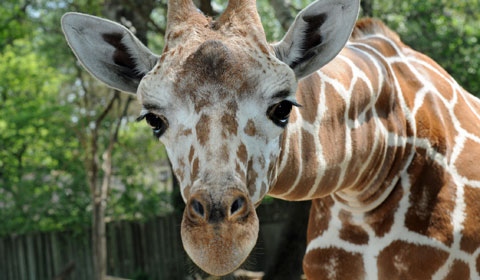News Release
June 25, 2014
FOR IMMEDIATE RELEASE
Note: Images of the white-cheeked gibbon infant and his family can be downloaded at the bottom of this page.
White-Cheeked Gibbon Born at Brookfield Zoo
Brookfield, Ill.—Oh boy, oh boy, oh boy! The Chicago Zoological Society, which manages Brookfield Zoo, is happy to announce the birth of a male white-cheeked gibbon on June 9. The infant is the third male born to Indah, 25, in the last five years. Currently, the entire gibbon family—including mom; her new baby; Benny, 29, the dad; and the baby’s two brothers Thani, 5; and Cuong, 2½—can all be seen in the zoo’s Tropic World: Asia exhibit between 10:00 a.m. and 1:00 p.m. As the baby gets older, the hours will be extended.
Since his birth, the infant has been keeping a close grip on his mom. He will stay in contact and be carried by Indah for a few more months. As he gets older, he will begin to explore the habitat on his own, become more independent, and play with his older brothers.
All white-cheeked gibbons are born with a blond coat matching their mother’s coat, a form of camouflage. Like those of his two older brothers, the new male gibbon’s coat will retain this light coloring until it begins to turn dusky when he is half a year old. By the time he reaches his first birthday, the young gibbon will be sporting a black coat with light cheek patches, like his dad and brothers. He will retain this coloration for life. Females turn black and then back to blond again, with a small patch of black on their crown, when they reach sexual maturity at around 6 to 8 years of age.
Indah and Benny have been together at Brookfield Zoo since August 1995. Indah was born at Minnesota Zoological Garden, and Benny was born in Leipzig, Germany. They are managed as a breeding pair based on a recommendation by the Gibbon Species Survival Plan (SSP) of the Association of Zoos and Aquariums (AZA). An SSP is a cooperative conservation program for the long-term management of an endangered species’ breeding, health, and welfare in North American zoos. Jay Petersen, curator of carnivores and primates for the Chicago Zoological Society, is the Gibbon SSP coordinator. With the assistance of the Gibbon SSP Management Group, he is responsible for management goals for all gibbons in AZA zoos and for breeding recommendations to ensure the sustainability of a healthy, genetically diverse, and demographically varied North American white-cheeked gibbon population. Currently, 88 white-cheeked gibbons live in 27 accredited North American zoos.
White-cheeked gibbons are critically endangered in their native habitat of Vietnam and the Lao People’s Democratic Republic. They are presumed extinct in their native China, as there have been no records of this species there since 1990. According to the International Union for Conservation of Nature (IUCN), the world’s oldest and largest global environmental organization, the species’ population is thought to have declined by as much as 80 percent in the last 45 years. The dramatic decline of white-cheeked gibbons in the wild is due primarily to hunting and habitat loss.
Gibbons are almost exclusively arboreal, making their homes high in the canopy of trees. Of the 250 or so species of primates in the world, gibbons are among the best suited to life in the trees. They swing with one arm, then the other, moving along the undersides of branches and vines, with their legs flexed under their body in what look like acrobatic displays. This form of locomotion is called brachiation. When they do descend to the ground or walk along a branch or vine, they walk on their legs while suspending their arms overhead to maintain balance—giving the appearance of walking an imaginary tightrope.
White-cheeked gibbons live as long-term male-female pairs with their offspring. They are very territorial, indicating their territory primarily through loud vocal displays, the sounds of which travel hundreds of yards through the forest. These duets reinforce the bond between a male and female and let other gibbons know a mated pair of gibbons is in residence. The females’ “great call” consists of a long rising series of notes that ends in a fast "twitter." The male’s duet of longer, lower notes is less complicated than the female’s song.
The Chicago Zoological Society, which manages Brookfield Zoo, inspires conservation leadership by connecting people with wildlife and nature. Open every day of the year, Brookfield Zoo is located off First Avenue between the Stevenson (I-55) and Eisenhower (I-290) expressways and is also accessible via the Tri-State Tollway (I-294), Metra commuter line, CTA, and PACE bus service.
# # #
PHOTO DOWNLOAD:
Photo Captions—photos by Jim Schulz/Chicago Zoological Society
White-cheeked gibbon-1, -2, -3, -4, and -5: A white-cheeked gibbon born at Brookfield Zoo on June 9 with his mom Indah, 25. The infant is the third male born to Indah in the last five years. Currently, the entire gibbon family—including mom; her new baby; Benny, 29, the dad; and the baby’s two brothers Thani, 5; and Cuong, 2½—can all be seen in the zoo’s Tropic World: Asia exhibit. White-cheeked gibbons are critically endangered in their native habitat of Vietnam and the Lao People’s Democratic Republic. They are presumed extinct in China. The dramatic decline of white-cheeked gibbons in the wild is due primarily to hunting and habitat loss.
White-cheeked gibbon-1.jpg
White-cheeked gibbon-2.jpg
White-cheeked gibbon-3.jpg
White-cheeked gibbon-4.jpg
White-cheeked gibbon-5.jpg
MEDIA CONTACT:
Sondra Katzen
Public Relations
Office: 708-688-8351
Cell Phone: 708-903-2071
E-mail: Sondra.Katzen@CZS.org

Read about our innovative practices in animal welfare to ensure the ultimate care of our individual animals.

We place a high priority on developing and supporting conservation leaders of all ages and backgrounds.

Create extraordinary connections with animals and nature!

Become our partner in caring for animals and in connecting people with wildlife and nature.